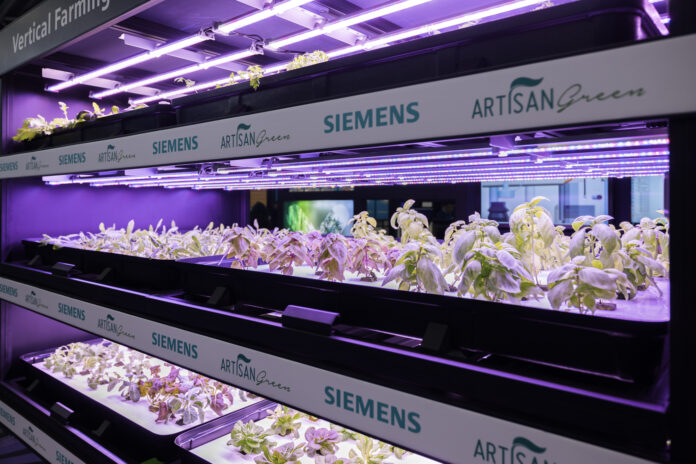Singapore is often lauded as a food paradise. Yet, according to the Singapore Food Agency, the country imports more than 90% of its food, making it vulnerable to food supply chain disruptions that could occur due to global factors such as climate change, disease outbreaks, geopolitical developments or export restrictions by foreign governments.
The Agency’s “30 by 30” goal will build the capability and capacity of Singapore’s agri-food industry to sustainably produce 30% of its own nutritional needs by 2030. In alignment with this, local indoor hydroponics farm Artisan Green has partnered with Siemens to pioneer a scalable integrated Farm Management System to accelerate farming practices nationwide and build a more resilient food future for the nation. This is expected to produce 25 tonnes of greens per month, which is estimated to generate a monthly supply of over 134,000 meals with leafy green vegetables.
In the first instalment of our two-part feature, SMEhorizon speaks with Ray Poh, Founder and Managing Director of Artisan Green, on his company’s partnership with Siemens, and how technology has enabled them to meet both productivity and sustainability goals. Isabel Chong, Head of Digital Industries for ASEAN at Siemens also contributes on Singapore’s Agriculture sector, and how digitalisation and automation can assist SMEs more generally. Read the second instalment here.
What are the main challenges Agriculture faces in Singapore?
[Isabel Chong] The agricultural sector in Singapore faces a few challenges due to the country’s limited arable land and resources. Labour shortage is a key challenge, since the Singaporean labour force that is willing to work in the labour-intensive agriculture sector is limited and the sector faces difficulties in attracting and retaining skilled workers. Hence, there is a need to embrace technology and innovation to sustain the agriculture sector in the long-run.
Another challenge is the current use of farming approaches that are not environmentally friendly and socially responsible. As a society, we need to farm and source food in ways that lessen climate change, reduce greenhouse gas emissions and biodiversity loss, and help minimise waste.
Currently, for example, 34% of all man-made greenhouse gas emissions are generated by food systems. One good way is to turn to sustainable farming methods, such as vertical farming and aquaponics, which can help reduce energy use and emissions.
The third challenge is the huge uncertainty around the crop yield, which is highly dependent on weather conditions. This uncertainty exposes Singapore to potential food security risks, given that the country is heavily dependent on imports, which account for more than 90% of its food supply. These risks are exacerbated by factors such as population growth, urbanisation, climate change, and unprecedented events like the COVID-19 pandemic.
[Ray Poh] One of the major challenges that we faced was the high energy costs as running indoor farms with controlled environments demands a significant energy input. In addition, the shortage of skilled professionals, particularly plant scientists and experts, made it challenging to find specialised talent to assist in our farming operations.
How does the Siemens Farm Management System help address these challenges?
[RP] To address these challenges effectively, we decided to partner with Siemens as they offered a comprehensive and highly scalable Farm Management System that aligns with our goals of enhancing productivity, sustainability and scalability. This system, through end-to-end automation, not only addresses the shortage of skilled labour through the digitalisation of growing protocols but also contributes to increased energy efficiency at the same time. In fact, we anticipate manpower savings of 112 pax, with the complete automation of all farming processes, from germination to harvesting, packing and cleaning.
In terms of energy consumption, indoor farms typically consume 38 kWh of electricity per kilogram of produce. In contrast, Artisan Green’s new farm, with the integration of Siemens’ Farm Management System and our proprietary technology, is projected to operate at a far more efficient rate of 15 kWh per kilogram of produce, exceeding the Singapore Food Agency’s standards.
Could you discuss some of the limitations you’ve faced with your previous Farm Management systems?
[RP] In our current farm, we’re using multiple separate systems within our growing operations. We use one system to measure temperature, humidity and carbon dioxide (CO2) and the system is equipped with sensors that trigger the dosing of CO2. We use another system to measure the pH and electrical conductivity (EC) of the nutrient solution and this system triggers the automatic dosing of concentrated nutrient solution into our nutrient reservoirs. The cooling equipment in our Growing Area operates independently of the first system.
All these separate systems and equipment work well on their own but monitoring all of them through their individual user interfaces is time-consuming. Because the data is stored and viewed separately, it is also difficult to see the link between the various operational factors. This makes more nuanced operational analysis difficult to perform. To solve any problems in production, we want to make sure our analysis is complete and thorough, and having data spread across multiple systems slows down our analytical process.
In the case of nutrient dosing, the existing system was limited in the scope of what it could achieve, and this limited our scientific process. What we wanted to do was to be able to dose any combination of nutrient solutions as part of our experiments and trials, and the system we were using was only able to dose one nutrient solution at a specific concentration set point. In this situation, we were forced to prepare any new combinations of nutrient solutions manually and this slowed down our experiments.
After studying our current situation, we decided that our best strategy would be to build the Farm Management System from the ground up. In this way, we could integrate the various sensor data right from the start into our database. The Siemen’s SCADA (Supervisory Control and Data Acquisition) system could also be integrated with our nutrient dosing technology, and this helped to add the data from the nutrient dosing protocols into the same database.
It became clear to us during the conceptualization phase that partnering with Siemens for our system integration would enable us to build a very powerful engine of efficiency and growth. Rather than taking minor steps to adapt our previous systems to what we needed, we decided to go with a total transformation that would advance us by multiple leaps and bounds.
How will automation and digitalisation help Artisan Green enhance crop quality and yield?
[RP] Automation and digitalisation play a pivotal role in enhancing the quality and yield of our crops at Artisan Green. Firstly, the technology we have enables us optimum precision. Automation enables real-time data collection and analysis, allowing us to have precise control over environmental factors and farming operations. This means we can maintain optimal conditions for our crops, resulting in healthier crops.
With Siemens’ Farm Management System, we can remotely access and monitor farm operations, making it easy to set and maintain optimal growing parameters from anywhere. We have also developed an integrated recipe control system that facilitates the selection of the right cultivation program for each crop. This system stores and manages recipes, including lighting intensity and duration, irrigation schedules, nutritional needs, and temperatures – all of which enhance resource efficiency and crop quality. Growing these crops in an indoor, controlled environment also helps to minimise the risk of crop diseases, pests, and weather-related disruptions.
The precision and control provided by automation and digitalisation also allow us to adjust sales planning and scheduling to efficiently meet demand and optimise seeding and growing tasks. As a result, we can better scale our production to meet the growing demands for local produce in Singapore, in line with our nation’s ‘30 by 30’ goals. With the Farm Management System in place, we are expected to boost our yield of leafy vegetables and herbs by 25-fold, from 1 tonne of output per month to 25 tonnes.
Sustainability is integral to our business, and these technologies allow us to achieve 95% reduction in water usage compared to traditional farming, reducing our farm-to-table carbon footprint while minimising overall waste throughout the harvest. Additionally, we utilise a range of advanced technologies to effectively cut the energy consumption of traditional indoor growing systems by half. This is projected to allow our new farm to operate at only 15 kWh per kilogram of produce, surpassing the Singapore Food Agency’s Clean & Green Standards.
All in all, automation and digitalisation will help enhance crop quality and yield by providing precision, control, and resource efficiency. These advancements not only support our nation’s ‘30 by 30’ goals but also contribute to sustainability and efficiency, allowing us to provide fresh, high-quality local produce at affordable prices for Singaporeans.
Are there lessons here that can be drawn for businesses more generally?
[IC] Digitalisation and automation enable companies to optimise their operations, increase productivity, reduce costs, and enhance decision-making. This can improve a company’s competitive edge and resilience with a more streamlined supply chains, greater efficiency, and strengthened business continuity.














